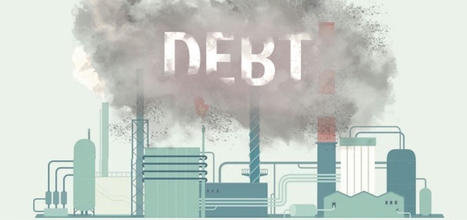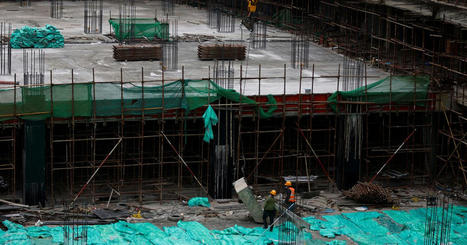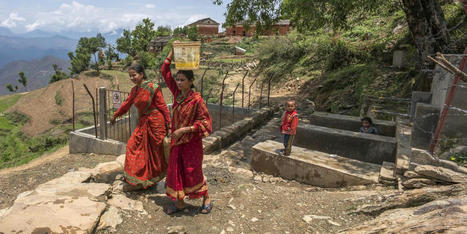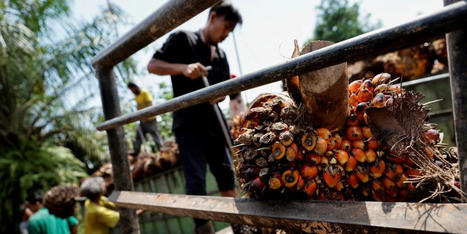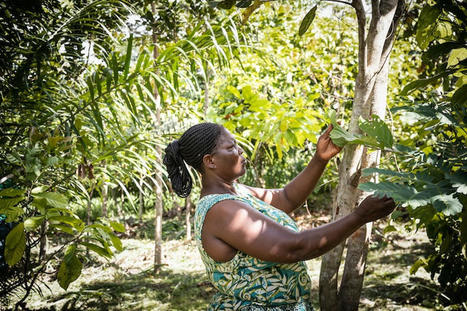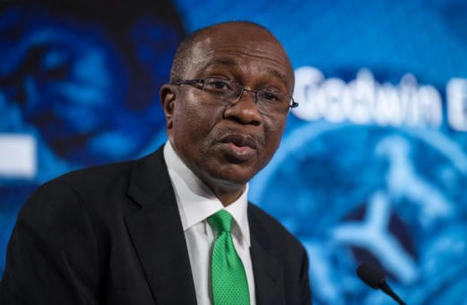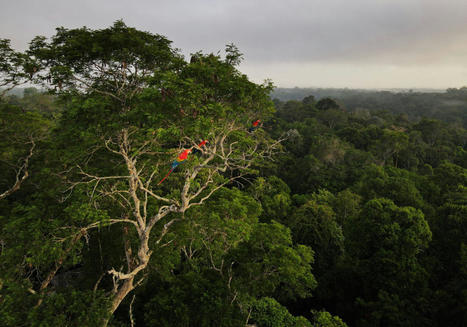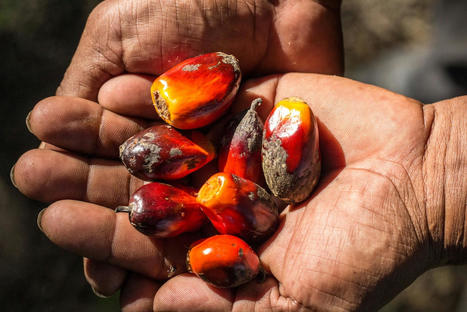 Your new post is loading...
 Your new post is loading...

|
Scooped by
Bruce Fellowes
July 7, 2023 5:02 AM
|
The country's economy was expected to blast out of the blocks after Covid - but that hasn't happened.

|
Scooped by
Bruce Fellowes
July 3, 2023 4:28 AM
|
On March 31 this year, Pakistan was ranked fifth in the list of countries with the highest borrowing from the IMF...

|
Scooped by
Bruce Fellowes
June 29, 2023 4:46 AM
|

|
Scooped by
Bruce Fellowes
June 2, 2023 6:18 AM
|
Tropenbos Colombia supported participatory productive restoration as an alternative approach to the government’s large-scale tree planting efforts. Tropenbos Colombia enabled farmers to establish restoration plots, supported inclusive landscape governance, and explored options for innovative financing.Significant parts of the Colombian Amazon region are degraded. This is caused, among others, by the expansion of cattle ranching and coca plantations, as well as the spraying of defoliant as part of an anti-drug programme. The central government’s approach to restoring these degraded lands is through large-scale and top-down tree planting efforts, using only a small number of fast-growing tree species. In the view of Tropenbos Colombia, this approach is risky. It pays no attention to the question of who is responsible for nurturing the seedlings and for ensuring that they can grow into mature trees. Tropenbos Colombia therefore put forward a proposition for an alternative approach: participatory productive restoration (PPR).PPR is based on the idea that restoration will be most successful when it engages communities and provides them with benefits, such as access to timber, fruits, firewood and water. By involving local communities, the restoration process becomes more sustainable, since the communities take ownership of the restored areas and are more likely to maintain them.In the context of the Working Landscapes programme, Tropenbos Colombia has promoted PPR in the Solano landscape in the southern department of Caquetá. This area has undergone rapid land-use changes in recent years, leading to widespread degradation, mostly due to the expansion of cattle pastures. Tropenbos Colombia has helped local people to establish restoration plots, while also improving governance and promoting business and finance in support of PPR.Restoration plotsAt the start of the Working Landscapes programme, Tropenbos Colombia invited Indigenous farmers and cattle ranchers in the Solano landscape to develop proposals for small-scale restoration initiatives. Tropenbos Colombia then provided technical support and a modest budget for seedlings and fencing materials, resulting in over one hundred local restoration plots — each tailored to specific ecological conditions and requirements. By the end of 2022, these areas were covered with a large variety of young trees, nurtured by their caretakers.Tropenbos Colombia witnessed formerly deforested areas coming back to life. Farmers recognized the power of restoration and its potential benefits for both them and the environment. They are enthusiastic about the approach, and have been extending PPR initiatives themselves. For example, communities that established tree nurseries with the help of Tropenbos Colombia have started providing seedlings to other communities, and some have applied for additional financial support to expand the area being restored. In addition, Tropenbos Colombia noticed a remarkable shift in attitude among the participating cattle ranchers. Whereas they once viewed the forest as an adversary, they have now come to regard it as an ally in securing their long-term livelihoods. They have begun to see themselves as guardians of the forest, committed to its preservation.Inclusive governanceTropenbos Colombia views PPR as part of an alternative rural development model in which local communities have rights to the natural resources they depend on, and are able to influence the decisions that affect the future of their immediate surroundings. Tropenbos Colombia therefore took steps to enhance the involvement of Indigenous and peasant communities in decision-making processes at the landscape level.Enthused by the success of the restoration initiatives, community representatives were keen to promote PPR at the municipal government level. With the help of Tropenbos Colombia they prepared themselves to participate during consultation meetings where stakeholders could provide input and feedback to municipal plans. They were able to make a convincing argument, backed up by data, maps and infographics. As a result, the municipal government decided to incorporate areas for PPR as a distinct category in its spatial plan, and in its plan to stop deforestation (affecting an area of around 1,5 million ha with approximately 10,600 people).Business and financeThe adoption of PPR could be accelerated through innovative business models and financing mechanisms. In his inauguration speech in August 2022, Colombia’s new president stated that one such financial mechanism — known as a debt-for-nature swap — was a viable way to conserve the country’s forest. This mechanism allows countries to have their debts decreased in exchange for their participation in environmentally-friendly initiatives.In the view of Tropenbos Colombia, debt-for-nature swaps could be used to support PPR, helping communities to build something that has value independent of external financial support. In the second half of 2022, Tropenbos Colombia therefore started presenting this idea to economists and financial experts from Vision Amazonia, a large government programme to prevent deforestation in the Amazon. The response was positive. Tropenbos Colombia will work with the programme to ensure that the government will use debt-for-nature swaps to invest in locally owned environmentally friendly initiatives that directly benefit local communities.UpscalingIn only three years, the work of Tropenbos Colombia to promote PPR has resulted in tangible changes in the Solano landscape, as well as changes to the spatial plans of the municipal government. Inspired by these successes, several other NGOs are now eager to support farmers in developing and implementing restoration initiatives. And, following discussions with Tropenbos Colombia, Vision Amazonia is considering including some elements of PPR in its strategy for the deforested parts of the Amazon basin. They realize that, in the long term, PPR is more sustainable than the government’s large-scale tree-planting projects. Crucially, it all starts with the Indigenous people and peasants themselves. They are key to ensuring that tree-planting efforts will ultimately contribute to long-term climate, biodiversity and livelihood objectives.This article is part of the TBI Annual review 2022.

|
Scooped by
Bruce Fellowes
March 6, 2023 4:26 AM
|
Subscribe to Newsletter By Yasmin Siddiqi, Bui Minh Giap Central Asian countries are facing major food security challenges, but can meet them by working together on shared solutions. Central Asia is emerging from a punishing winter. With farms blanketed in thick snow, unusually low temperatures have curtailed harvests for certain vegetables. Some countries like Uzbekistan and Kazakhstan have temporarily halted the export of onions due to the impact of the harsh winter. None of this helps food prices, already elevated because of overlapping crises. Last year, the region saw a double-digit rise in food price inflation from trade disruptions caused by the Russian invasion of Ukraine and supply chain disruptions due to the lingering effects of the pandemic. It’s another grim reminder that challenges to food security are ever present. Water volumes in the Syr Darya and Amu Darya river basins, a vital source of irrigation water for up to 10 million hectares of land in Central Asia, are expected to drop by up to 15%. Melting glaciers will further exacerbate crop timing and watering as river flows will peak earlier in the year. While there are no easy answers, clearly the region will require significant investment and financing to develop more productive, resilient, and sustainable agriculture. Regional cooperation can also help to shore up food security. In one of the most landlocked parts of Asia, closer collaboration between Central Asian governments can help to drive climate-resilient and sustainable food production, and boost trade to meet gaps in food needs. Members of the Central Asia Regional Economic Cooperation (CAREC) Program, a partnership of countries in Central Asia and beyond, took a step in the right direction last year. In November, they endorsed a new cooperation framework that will see them work together more closely in agricultural development and food security. Here are three ways they plan to collaborate. First, by sharing best practices in agriculture. Food products such as wheat, rice, and maize make up most of the region’s agricultural products, but yields are generally low given that many farms across the region are small with low levels of mechanization. The average farm in Azerbaijan, the Kyrgyz Republic, Pakistan, and Tajikistan is about 1-3 hectares. These relatively small-scale farms also limit the ability of farmers to access financing for farm inputs and technology that would boost production. Yet, elsewhere in the region, modern agricultural practices are helping to boost yields. The People’s Republic of China, for example, has introduced technology that uses less irrigation water by distributing it at low pressure through a piped network. Kazakhstan has been using data on soil, weather, and crop yields collected by drones and satellites to optimize yields from fertilizers and pesticides. And pilot projects in the country based on this approach, known as precision agriculture, show promise: increasing livestock milk yields by 18%, cutting crop farming costs by 20% and boosting cereal yields by 2.5 metric tons per hectare. Another way knowledge can be shared is through education and research. Developing vocational training and higher education programs in modern farming methods will help equip the next generation of farmers and agricultural professionals, particularly if these programs are targeted at girls and young people in rural areas. Joint research into higher yielding crop varieties that are resilient to pests, epidemics, and changing water conditions will help improve yields. While there are no easy answers, the region will require significant investment and financing to develop more productive, resilient, and sustainable agriculture. Second, by working together to develop food value chains. Key components of food value chains, including storage services and food processing, remain underdeveloped in most Central Asian countries, where up to 25% of harvested fruits and vegetables is lost. Countries in the region can address these weaknesses by putting in place a conducive business environment that will encourage the private sector to invest in facilities and services that are vital to securing food supply. It is essential that governments improve strategic production planning and zoning, develop public infrastructure, and secure land tenure for primary agriculture and post-harvest processing. Providing transparent incentives for private sector businesses and protecting their assets once invested are also important. Third, by improving food safety systems to expand trade. Many CAREC countries have outdated food safety management systems and sanitary and phytosanitary measures inconsistent with international standards. The CAREC program is advising its members on strengthening food safety systems and adopting electronic sanitary and phytosanitary certification systems that are more efficient and transparent to update these standards. Improving food safety systems and aligning them with international standards will help to boost food trade within the region and help ensure food is available and affordable. It can also attract foreign direct investments into the food industry which can help to boost supply, meeting countries’ food needs and expanding markets for their products beyond the region. Countries in Central Asia are facing major food security challenges, but there is great potential for long-term solutions by working together under the new cooperation framework. Published: 2 March 2023

|
Scooped by
Bruce Fellowes
February 20, 2023 6:59 AM
|

|
Scooped by
Bruce Fellowes
February 20, 2023 6:46 AM
|

|
Scooped by
Bruce Fellowes
January 25, 2023 8:19 AM
|
Three out of four people are worried about the rising inflation and want the government to introduce decisive measures to tackle the same...

|
Scooped by
Bruce Fellowes
January 17, 2023 11:25 AM
|
China's economic growth in 2022 slumped to one of its worst levels in nearly half a century as the fourth quarter was hit hard by strict COVID curbs and a property market slump, raising pressure on policymakers to unveil more stimulus this year.

|
Scooped by
Bruce Fellowes
January 17, 2023 9:46 AM
|

|
Scooped by
Bruce Fellowes
December 23, 2022 4:41 AM
|
Nearly three years after the coronavirus was first identified in China, it is now spreading through the country and experts predict difficult months ahead for its 1.4 billion people...

|
Scooped by
Bruce Fellowes
December 23, 2022 4:36 AM
|
As dusk descends on the dimly lit central business district of Zimbabwe's capital Harare, a steady stream of home-bound workers flows into a sea of informal traders hawking a mixture of basic...| December 23, 2022...

|
Scooped by
Bruce Fellowes
December 23, 2022 4:25 AM
|
In Nepal’s mountain eco-regions, the needs of women and vulnerable groups were considered in designing a project that protects water resources from climate risks.
|

|
Scooped by
Bruce Fellowes
July 3, 2023 4:32 AM
|
According to regional reports from China at this year’s trade expo on Friday, the expo is expected to generate deals worth $19 billion.

|
Scooped by
Bruce Fellowes
July 3, 2023 4:27 AM
|
Diana Choyleva is chief economist of Enodo Economics, a macroeconomic and political forecasting company in London focused on China and its global impa...

|
Scooped by
Bruce Fellowes
June 5, 2023 5:53 AM
|
The United States House of Representatives recently approved "the PRC Is Not A Developing Country Act".The unanimous decision requires the US Department of State to change China's status as a "developing country" in international organizations where the United States participates in or is a part...

|
Scooped by
Bruce Fellowes
June 2, 2023 6:16 AM
|
The Board of Directors of the African Development Bank Group (www.AfDB.org) has approved an equity investment of $20 million in the Africa50 Infrastructure Acceleration Fund I (https://apo-opa.info/3MOlP3b), in support of its target to mobilize private capital for infrastructure across the continent. The Africa50 Infrastructure Acceleration Fund I is a pan-African infrastructure private equity fund that is mobilizing up to $500 million for investment and value creation in strategic infrastructure sectors. These include power, energy, digital and social infrastructure, transportation, logistics, and water and sanitation. The fund is sponsored by Africa50 (https://apo-opa.info/3OLnr05), an infrastructure investment platform established by governments and the African Development Bank. Africa50 brings infrastructure project development and financing under one umbrella. Africa50 has a strong track record of investments in the private sector and of projects undertaken under a Public Private-Partnership (PPP) framework. The mobilization of private capital is critical to closing the infrastructure financing gap in Africa, especially given the limited fiscal space of African governments which currently provide the largest source of infrastructure funding on the continent. The Africa50 Infrastructure Acceleration Fund I was established as a vehicle to help execute Africa50’s mandate of mobilizing private capital and accelerating further investment flows into African infrastructure by targeting private and institutional investors. African Development Bank Director for the Industrial and Trade Development Department, Abdu Mukhtar said the Bank’s investment in the Fund underlined its strategic nature and the fact that the Bank prioritizes investing in strategic infrastructure sectors that contribute to closing Africa’s infrastructure financing gap (estimated at $68-108 billion annually). “The Bank’s investment will support Africa50 to crowd-in private capital into African infrastructure through a private equity fund vehicle that private investors better understand and are more comfortable investing in,” Mukhtar said. Commenting on the approval, Wale Shonibare, African Development Bank’s Director for Energy Financial Solutions, Policy and Regulations said the Bank’s support for the Africa50 Infrastructure Acceleration Fund I aligned with its High Five objectives. “It also strengthens the Bank’s already existing partnerships with the Africa50 Group on initiatives such as the African Sovereign Investors Forum and the Alliance for Green Infrastructure in Africa,” Shonibare added. Alain Ebobissé, CEO of the Africa50 Group, said: “We are highly appreciative of the African Development Bank’s support for the Africa50 Infrastructure Acceleration Fund I. We look forward to continuing to work collaboratively with the African Development Bank and other investors to make a meaningful contribution to improving the infrastructure landscape on the continent.” By leveraging private capital for infrastructure investment, The Africa50 Infrastructure Acceleration Fund I can help create jobs, strengthen healthcare access, improve education access through digital technologies, enhance access to financial services and financial inclusion through fintech investments, and reduce the impact of climate change. The fund is projected to create 3,278 full-time equivalent jobs over the period 2023-2035, including 1,676 jobs for women. In addition, the fund is expected to contribute to fostering regional integration through improvements in transport and logistics infrastructure that can lead to increased inter and intra-regional trade. The African Development Bank and partners in the new fund will continue to provide growth capital and infrastructure equity to support the urgent need to accelerate private sector funding toward bridging the infrastructure financing gap in Africa. SOURCE African Development Bank Group (AfDB Share on Social Media twitter facebook emailwhatsapptelegram Post Views: 12

|
Scooped by
Bruce Fellowes
February 20, 2023 7:56 AM
|
Decision hailed as the right move as it will spur the growth of both aviation and tourism...

|
Scooped by
Bruce Fellowes
February 20, 2023 6:52 AM
|
JAKARTA (Reuters) -- Indonesia booked a current account surplus of $13.2 billion in 2022, or 1% of gross domestic product, as the resource-rich countr...

|
Scooped by
Bruce Fellowes
January 25, 2023 4:04 PM
|
Fairtrade is set to enhance its sustainability work with plans for a new online mapping system in a bid to identify human rights and environmental risks in...

|
Scooped by
Bruce Fellowes
January 25, 2023 8:17 AM
|
The Central Bank of Nigeria (CBN) has increased the Monetary Policy Rate (MPR) by another 100 basis points, to 17.5 percent from 16.5 percent, as part of its attempts to control inflation through monetary tightening.

|
Scooped by
Bruce Fellowes
January 17, 2023 9:57 AM
|

|
Scooped by
Bruce Fellowes
December 23, 2022 6:40 AM
|
China’s autocrat has had a surprisingly bad year.

|
Scooped by
Bruce Fellowes
December 23, 2022 4:40 AM
|
The World Bank?s board of directors approved late on Thursday a $500 million project in Brazil to expand sustainability-linked finance and strengthen the private sector's capacity to access carbon...

|
Scooped by
Bruce Fellowes
December 23, 2022 4:29 AM
|
The role and remit of the industry’s leading certification body were the focus of the first in-person meeting since 2019.
|

 Your new post is loading...
Your new post is loading...
 Your new post is loading...
Your new post is loading...





